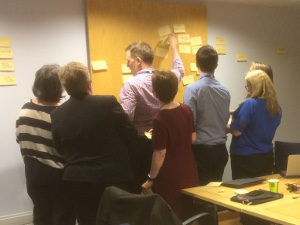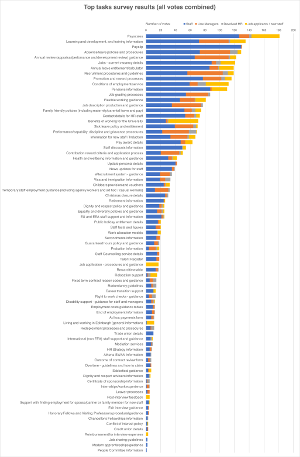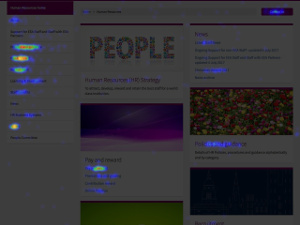Looking back on our website enhancement collaboration with Human Resources
We have recently completed a six month collaboration with University Human Resources Services (UHRS) which has delivered a fledgling digital strategy, developed new content management processes and skills within their team, and rationalised priority areas of their website.
Human Resources have a large web estate. An early audit identified over 1,500 pages and documents, which was challenging for their busy team to keep on top of. Within this web estate is some of the University’s most important guidance, called upon by a range of audiences on a daily basis.
So it was important for us to work closely with the HR team to understand their priorities and challenges, and those of their key audiences, so that we could spend the time we had on areas where our shared efforts would have the greatest impact. We also wanted to help the team to establish new skills and processes to enable improvement to continue after we stepped back.
In this post, I will outline how we approached the project and tackled the priorities we established with the HR team:
- Audits to assess the existing state
- Content management
- Learning and Development
- Strategy workshops
- User research
- Interviews
- Top tasks surveys
- Further site analysis
- Collaborating with the wider HR community
- Making sense of the insight
Audits to assess the existing state
We have a range of auditing tools available to help us understand the size and shape of a website.
- Google Analytics
- Sitebeam (wiki – EASE login required)
- Snapshot
Using these tools, we immediately identified that HR had over 800 pages. The majority of those got an average of less than one pageview a day across the previous year.
This gave us a pretty good idea that HR had pages that needed to be unpublished. But we needed more evidence about which pages needed to go. Because of the nature of some of HR‘s content, we may need to keep it, even if it is not frequently visited.
But we knew it was important to remove some content, for two reasons. Firstly, unnecessary content causes clutter, and makes it more difficult for people to find what they are looking for. Anecdotal evidence suggested that this was a problem with the HR website, and it was one of the reasons they asked to collaborate with us.
Secondly, a larger website means you need more resource to maintain it. So it was important for us to understand how much time HR were spending on maintaining the website, and investigate how their content management processes could be improved.
Content management
I interviewed the majority of HR‘s EdWeb users to find out how the website was managed, and identify pain points in their process. Some key findings came out of these interviews, and this heavily influenced the direction of the project.
In particular, a number of people said they lacked awareness of the capabilities of EdWeb, and felt that colleagues could benefit from understanding more about web content best practice.
To fill this gap, we delivered a tailored training session, aimed at bringing their team up to date with EdWeb and creating effective digital content.
Tailored training to improve skills in publishing digital content — read the blog post.
The interviews also identified a particular pain point around the management of policy documents. UHRS had been managing these with a legacy solution outside of EdWeb. We have now migrated around 200 documents into EdWeb, where they can be more easily managed and supported.
Learning and Development
UHRS asked us to focus in particular on the Learning and Development webpages. We knew from the audits carried out at the start of the project that these pages took up more than a third of HR‘s total. Learning and Development had around 300 webpages promoting 80 development options.
My colleague Nick Daniels worked closely with the Learning and Development team to improve their webpages. In the end, we were able to radically trim down the number of pages.
We also improved the process of listing courses for staff development. Previously, UHRS staff had to update course listings in two places, which required manual work to keep the two listings in sync. Now, a single golden copy feeds through to both listings. This means users see up to date information, and UHRS staff have one less job to do.
Read more about our work on the Learning and Development pages.
Strategy workshops

Colleagues in UHRS working together to prioritise their requirements.
Throughout the project we ran strategy workshops. These were designed to bring the team to a common understanding of their priority audiences, the needs of their users, and their business objectives with those users. We developed a bespoke workshop format in order to meet UHRS‘s needs and the way they were able to work with us.
By the end of the workshops, we had developed a matrix of business objectives and user needs. Most importantly, because we had collaborated with colleagues across HR, the new strategy was based on a consensus, helping to bring the team on board.
Bespoke workshops to develop a Human Resources digital strategy — read more in the blog post.
The decisions reached in the workshops formed the basis of HR‘s new digital strategy. The workshops enabled us to develop a strong idea of our business objectives, who the priority audiences are, and our perception of our users’ needs. But we needed to verify that with some further research.
User research
Interviews
The beauty of working with HR is that many of their target audiences are staff members, all around us in the University. So it was relatively straightforward to gain access to representatives of our prioritised audiences and get the insight we needed.
In particular, we focused on speaking to members of devolved HR teams. These people have needs of their own from the Human Resources website. But unlike most staff members in UHRS, they also deal with day-to-day HR enquiries from University staff members.
This makes devolved HR teams uniquely insightful when it comes to not only their own needs, but also the needs of UHRS‘s other target audiences. Nothing in this project was more valuable than speaking to our users. If I could change one thing about this project, it would be to interview our users earlier and more often.
Observing our users brings unparalleled insight — read the blog post.
Top tasks surveys

Top tasks results show us which areas are of most importance, and for which audiences.
We also conducted top tasks surveys with HR‘s four prioritised audiences.
Top tasks management – how to continuously measure your website’s success — read the blog post.
Part of the motivation behind interviewing devolved HR staff was to verify our top tasks lists. In the end, we drew together around 80 tasks. We sent out four separate surveys — one to each of the four prioritised audiences — and asked users to select their top five reasons for using HR services.
On analysing the data, we produced long neck and long tail graphs of users’ top tasks. This gave us a clearer idea of what the HR website needs to focus on if it is to meet users’ needs.
Optimising what’s important – Get to know your long neck — read Neil Allison’s blog post.
Further site analysis
Nick did some great work delving further into Google Analytics to gain a deeper understanding of what search terms people used to reach the HR webpages. This gave us another source of evidence as to what people came to the HR website for.

We also installed CrazyEgg on the HR homepage for two weeks. This generated a heatmap, enabling us to see which areas of the homepage were of interest to our users, and which links were never being clicked.
Requesting a Crazy Egg report (wiki – EASE login required).
Collaborating with the wider HR community
Towards the end of the project, we had a fantastic opportunity to run a session as part of the Human Resources community away day. This event brought together around 80 staff from both the central HR service and devolved HR teams.
This was a unique chance to present our findings so far to the wider HR community. But it was also a valuable opportunity to get central and devolved staff members working together to better understand each other’s perspectives.
We ran an activity where groups collaborated to generate user stories for the top tasks identified in the survey of devolved HR staff. For members of devolved teams, this was an opportunity to express the motivation behind their top tasks. For UHRS staff, it was an exercise in empathising with one of their most important audiences.
Read more about user stories — Focusing student support web content.
After generating their user stories, each group voted for their top priority. We now had prioritised user stories for our prioritised top tasks. The result was greater insight into how HR can better meet core user needs through their website.
Making sense of the insight
By now we had several sources of information. We looked for corroboration among these different sources to understand what really matters. Some common themes emerged. For instance, pay scales, payslip and conditions of service all came up time and again in our analysis.
What is interesting is that many of the patterns we found through user research did not emerge during the workshops. The workshops were valuable in identifying key business objectives and priority audiences. But user research was a vital stage on top of this, to enable us to add the appropriate level of depth to the new HR digital strategy.
Because of the approach we took, we were able to ensure that HR now have a robust digital strategy that is genuinely focused on real user needs as well as their business objectives.
Get in touch
If you would like to collaborate with us to gain a greater understanding of your users’ needs and priorities, get in touch with us to explore the options.

